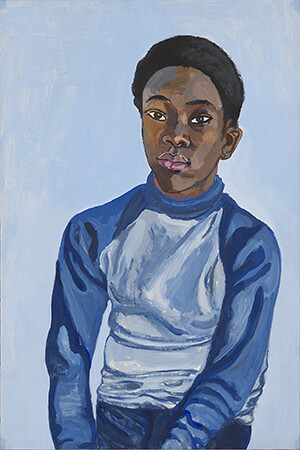May 18–July 29, 2017
Victoria Miro
16 Wharf Road
London N1 7RW
Curated by Hilton Als
Curated by the celebrated US author and Pulitzer Prize winning critic Hilton Als, Alice Neel, Uptown focuses on paintings made by the artist during the five decades in which she lived and worked in upper Manhattan, first in Spanish (East) Harlem, where she moved in 1938, and, later, the Upper West Side, where she lived from 1962 until her death in 1984.
A woman with a strong social conscience and equally strong left-wing beliefs, Alice Neel moved from the relative comfort of Greenwich Village to Spanish Harlem in 1938 in pursuit of “the truth.” There she painted friends, neighbours, casual acquaintances and people she encountered on the street among the immigrant community, and just as often cultural figures connected to Harlem or the civil rights movement. Neel’s later portraits, made after moving to the Upper West Side, reflect a changing milieu, yet remain engaged more or less explicitly with political and social issues, and the particularities of living and working under, as Neel put it, “the pressure of city life.”
Highlighting both the innate diversity of Neel’s approach to portraiture and the extraordinary diversity of twentieth century New York City, in this exhibition Hilton Als brings together a selection of Neel’s portraits of African Americans, Latinos, Asians, and other people of colour. As Als writes, “what fascinated her was the breadth of humanity that she encountered.”
The selected portraits include cultural and political figures admired by Neel, among them playwright, actor, and author Alice Childress, and sociologist Horace R. Cayton, Jr., whose 1945 Black Metropolis: A Study of Negro Life in a Northern City is among the key academic studies of the African American urban experience in the early twentieth century.
The exhibition at Victoria Miro follows its presentation at David Zwirner, New York (February 23 through April 22, 2017).
An accompanying catalogue, jointly published by David Zwirner Books and Victoria Miro, will include essays by Hilton Als on individual portraits and their sitters, in addition to new scholarship by Jeremy Lewison.
“From the start Alice Neel’s artistry made life different for me, or not so much different as more enlightened. I grew up in Brooklyn, East New York, and Crown Heights during the 1970s when Neel, after years of obscurity, was finally getting her due. I recall first seeing her work in a book, and what shocked me more than her outrageous and accurate sense of color and form—did we really look like that? We did!—was the realisation that her subject was my humanity. There was a quality I shared with her subjects, all of whom were seen through the lens of Neel’s interest, and compassion. What did it matter that I grew up in a world that was different than that which Linda Nochlin, and Andy Warhol, and Jackie Curtis, inhabited? We were all as strong and fragile and present as life allowed. And Neel saw.
“In the years since her death, viewers young and old have experienced the kind of thrill I feel, still, whenever I look at Neel’s work, which, like all great art, reveals itself all at once while remaining mysterious. In recent years, I have been particularly intrigued by Neel’s portraits of artists, writers, everyday people, thinkers, and upstarts of colour. When she moved to East Harlem during the 1930s Depression, Neel was one of the few whites living uptown. She was attracted to a world of difference and painted that. Still, her work was not marred by ideological concerns; what fascinated her was the breadth of humanity that she encountered in her studio, on canvas.
“But by painting the Latinos, blacks, and Asians, Neel was breaking away from the canon of Western art. She was not, in short, limiting her view to people who looked like herself. Rather, she was opening portraiture up to include those persons who were not generally seen in its history. Alice Neel, Uptown, the first comprehensive look at Neel’s portraits of people of colour, is an attempt to honour not only what Neel saw, but the generosity behind her seeing.” –Hilton Als
Alice Neel was born near Philadelphia, Pennsylvania in 1900 and died in 1984 in New York. Alice Neel: Painter of Modern Life, a major survey of the artist’s work was organised by Ateneum Art Museum, Helsinki in 2016. It subsequently travelled to the Gemeentemuseum, The Hague, and is on display at the Fondation Vincent Van Gogh in Arles, France (until September 2017), before concluding at the Deichtorhallen Hamburg. The Estate of Alice Neel has been represented by Victoria Miro since 2004; this is her sixth solo exhibition with the gallery. Her work is in the collections of major museums internationally.
Hilton Als became a staff writer at The New Yorker in 1996, a theatre critic in 2002, and chief theatre critic in 2013. He has also written articles for The Nation and The New York Review of Books, among other publications, and has collaborated on film scripts for Swoon and Looking for Langston. He was awarded a Guggenheim for Creative Writing in 2000 and the George Jean Nathan Award for Dramatic Criticism for 2002-03. In 2016 he was awarded a Windham-Campbell Prize for Non-Fiction. In April 2017 Als was awarded the Pulitzer Prize for Criticism. Als is an associate professor at Columbia University School of the Arts and has taught at Wesleyan, Wellesley, Smith, and the Yale School of Drama. He lives in New York City.


